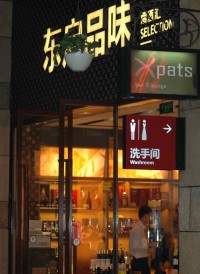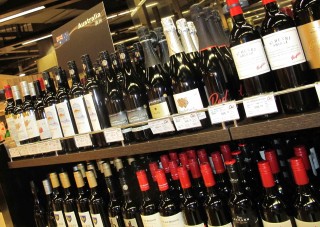A wine enthusiast with an unnervingly accurate palate, he has correctly guessed the type, variety, vintage and price range of an Eden Valley riesling, a straightforward Barossa shiraz and a Barossa Grenache Shiraz Mouvedre. The 31-year-old has yet to visit Australia, let alone the Barossa, but he’s not about to confuse a shiraz with a shiraz blend.
His fellow enthusiasts clap. Ip looks a little shy, and tries to give his third prize of the day – a Barossa tea-towel – to a runner-up.
One of the 18 Chinese (and one French) wine students sitting behind tables covered with serried ranks of wine glasses, plates of water crackers and discreet spittoons, Ip is enjoying this blind-tasting crescendo to a day dedicated to wine, specifically to vintages from the Barossa. These advanced wine students have paid big bucks (about $370 each) to join this intensive wine appreciation course.
Ip is sold on Australian wine. “Many of the Chinese have the wrong perception, they think the best must come from France,” he says reflectively. “Bordeaux, it can get a bit boring I think.”
With a population of 1.3 billion, and an economy which is predicted to soon overtake America’s, China is a nation worth cultivating and Australian winemakers are giving it their best shot with a range of different charm offensives.
Each year, between five and six thousand Chinese tourists are welcomed at Jacob’s Creek vineyard with tours in the Mandarin language. Chinese wine-writers and wine-sellers have been brought to Australia to see the vineyards and taste the wines. Both Wine Australia and the Barossa Grape and Wine Association are running or planning wine courses in Hong Kong and mainland China.
Now on a trial run in Hong Kong before the big leap to the mainland, the Barossa school is the only regional Australian wine course of its type and one of the weapons deployed in the battle to encourage Chinese wine-drinkers to look beyond Bordeaux. The idea is to foster an understanding of the pleasures of drinking not just any old plonk but superior Barossa vintages.
In the austere conference room high up the Hong Kong skyscraper, Ip listens intently as the Barossa school wine expert describes each wine in glowing terms: subtle and elegant; a nose with citrus, honey, rose petal, or marmalade notes, or spice, or even pebbles; a shiraz that lingers, or a grenache with a round middle palate. Acidity, tannin, aroma, clarity, intensity, sweetness: the expert asks the audience to consider the whole gamut of wine characteristics.
 This vintage, he says, holding a glass to his nose, has flavours of “beautiful strawberry fruit” with a hint of “French green bean”. Smiling and nodding, the nascent conoisseurs scribble notes, and enjoy another sip. Kalleske Clarry’s GSM (Grenache Shiraz Mataro) 2011 gets the tick of approval.
This vintage, he says, holding a glass to his nose, has flavours of “beautiful strawberry fruit” with a hint of “French green bean”. Smiling and nodding, the nascent conoisseurs scribble notes, and enjoy another sip. Kalleske Clarry’s GSM (Grenache Shiraz Mataro) 2011 gets the tick of approval.
Ip, for one, wants to know more, and he plans to join the Barossa school tour to South Australia in September, adding private trips to the vineyards of Tasmania and Margaret River in WA. A bank official, he finds the world of wine infinitely more appealing than finance and as a sideline he now owns a small on-line retailer, Picco Wine Cellar.
Picco only has a single Australian wine on the website, but Ip says he has more he hasn’t yet listed. He buys wine at auction and he sells wine to friends and to some restaurants in Hong Kong. “Nowadays I just love bidding for Australian wine at auction,” he says. “I think it’s undervalued and I think it’s a good bargain.” Ip likes the variety of Australian wine, the Barossa shirazes, Tasmanian and West Australian vintages and the Clare Valley rieslings. “People have the wrong perception, they think Australian wine is party wine, and it can’t compare with fine wine from the old world. But nowadays there are many, many fine wines from there.”
Yet this enthusiast didn’t grow up with wine on the table. Wine was never drunk in the Ip home, and his parents didn’t order wine when they dined in restaurants. Ip first became interested in wine about seven years ago, and he soon began taking courses and going to wine-tastings, and now he even teaches a little. “It all started and was driven by passion,” he says with a smile.
Sitting in the back of the Barossa school course and keeping an eye on proceedings is the wine expert and connoisseur Lucy Anderson, from the marketing consultancy WineHero who put together not only this course but the Wine Australia wine appreciation course as well.
South Australian born and bred, and now a resident of Hong Kong, she is a whole-hearted advocate of Australian wine and she has some concerns about the booby-traps inherent in marketing Australian wine in China. A great deal of all wine consumed in mainland China, both domestic and imported, is sold or distributed through an opaque “closed market”, she says. In Australia, a wine consumer would probably buy a bottle at a local bottle shop, take it home, open it and drink it. In China, group buyers and corporates dominate the market. Sometimes wine is part of a pay packet, sometimes it’s used for all-important banquets. Sometimes it’s used as company gifts.
Chinese importers buy large quantities of Australian bottled wine to label as their own; but these “buyer’s own brand” products are likely to still feature the provenance of the wine, Australia, and sometimes a region. Anderson believes at least half of all Australian wine imported into China is used for these buyer’s own brands. If the wine is stored in the wrong conditions, or kept too long (sauvignon blanc, for instance, should be usually drunk within a year of bottling) and the wine is spoiled or “cooked”, it will eventually damage Australian’s reputation as a premier wine producer.
“It’s just a lack of knowledge,” Anderson says, with a shrug. “The common perception might be that all wines improve with age.”
Some wine trades in China are used as vehicles to help Chinese citizens to establish a trading history and acquire residence visas in Australia; they might import $400,000 worth of Australian wine in one hit, and there are agents to help them do it, she adds. In Hong Kong, too, there can be a lack of real experience among wine importers, where the numbers burgeoned from a few hundred to more than 3,000 after the wine tax was eliminated in 2008.
Few Chinese people have grown up with wine, so they have little experience of the casual bottle on the table at dinner, the weekly or monthly perusal of restaurant wine lists, the everyday event of wine enjoyed at parties or dinners with friends. The few Chinese who do drink wine mostly drink red, perhaps because Chinese generally don’t like to drink any cold liquids, even water.
Many Australians absorb a great deal of wine knowledge absent-mindedly, almost by osmosis. In China, by way of contrast, it’s still an unusual habit and on a per capita basis the Chinese still only drink tiny amounts of wine. As an indication, the British research company IWSR has calculated that Chinese consumption of still light wines per person more than doubled in four years, from .49 of a litre annually in 2008 to 1.15 litres in 2012. Australian consumption of the same type of wine, by way of comparison, hit 21.31 litres in 2012.
Chinese interest in wine is growing as the professional classes expand in the major cities. Wine is sold in large supermarkets, in specialist wine shops and by online retailers. There are Chinese wine blogs, wine apps, wine television programs and even a television drama series, titled Scent of Beauty, apparently about young people and the wine industry. It’s thought that between 2012 and 2016, Chinese wine consumption will increase by 40 per cent. Joyous news for Australian vintners.
But there’s a sobering reality behind the fizz of expectation. China itself is producing more and more wine, and its wine production is likely to to overtake Australia’s next year. Heavy investment in international viticulture and viniculture expertise is expected to pay dividends, say experts like Lucy Anderson, but there are some huge obstacles for Chinese vineyards to overcome. Vineyards in Ningxia, in the nation’s north-west, are covered by snow in the winter, and the vines have to be buried to keep them alive. Only young vines can bend sufficiently for burying, meaning that Ningxia has none of the older, gnarly vines that produce rich vintages. Further east, in the vineyards of Shandong province on the coast, air-borne pollution has been a concern.
Some Australian winemakers fear China’s massive output, which includes some fine wines, could put a dent in the import numbers, which Wine Australia reports as a substantial 41 million litres in the year to March.
Wine importer and distributor Campbell Thompson, for one, believes Australia has to concentrate on pushing the premium vintages because the “cheap and cheerful”field is getting very crowded. The South Australian has been working with wine in China for a decade or so, and he has his finger on the pulse as the managing director and co-founder of the Australian-owned Wine Republic, which has branches in Beijing, Shanghai and Shenzhen. Speaking competent Mandarin, he knows the market.
“Obviously there’s a far greater number of people now consuming imported wine than there were ten years ago,” he says. “It’s definitely of tremendous interest to young, urban, white-collar, middle and upper middle class people to learn about wine because it’s fun, because it’s social and because it’s something that gives them confidence when they’re dealing with people of different backgrounds.”
The Wine Republic is concentrating on the minority of Chinese wine-drinkers who actually buy their own wine to drink, and Thompson says it is a rapidly growing minority who appreciate fine wines. “Over the last three, six, nine months, there has been a significant change in the market, and it offers some real opportunities for Australian winemakers,” he says, adding that his experience suggests the ‘flavour profile’ of Australian wines is generally one that’s enjoyed by Chinese wine-drinkers. “We want the consumers to know what it is they’re buying, and to like it, and seeking it out in the future because they like it, because it tastes good.”
The company’s bilingual website, which features wine from eight countries, makes it clear that the transport and storage of wine in China is often less than ideal. The company, the website says, cares deeply about the quality of wine it markets: “This is why every bottle we sell travels to China inside a refrigerated container, is stored in warehouses with full temperature and humidity control once it’s here, reaching you in the best possible condition.”
Thompson says Chinese drinkers often start with Bordeaux before graduating. to cabernets from the Coonawarra. “We have customers who buy large quantities of them, like Parker Estate. These customers find the Coonawarra wines still have the body and the style that they find in Bordeaux, and they’re just as serious, but they’re much more approachable. The irony is that some people perceive the wines as being not expensive enough.”
McLaren Vale wines, too, are enjoyed by Chinese drinkers. Some important Chinese visitors recently visited Chapel Hill, Thompson says, and they were astonished at the quality of the wines. Chinese tea-drinkers nearly always appreciate the tannin and structure of good Australian wines, he adds. “They get it right away.”
“A lot of people here are looking beyond Bordeaux. They’re realising that there are some great wines made in other parts of the world.”
The wagyu steak is sizzling in the open-view kitchen, the diners are relaxing in their plush high-backed chairs, and the Australian wine is ready to be enjoyed. Here at the Grange Grill restaurant, in the Westin hotel in southern China’s industrial megacity of Shenzhen, the scene is set for luxury.
According information provided by the hotel, the Grange Grill has “aligned” itself with the Penfolds Winery; “in particular with their iconic wine ‘Grange’, the most famous of the wines from Australia” and a range of Grange vintages have been “painstakingly procured creating an extremely rare selection of truly collectable wines”.
Penfolds, and especially Penfolds Grange, has a huge reputation in China, and the label has already had the dubious accolade of at least one enterprising faker, ‘Benfolds’, cashing in on the name.
The Grange Grill carries ten Grange vintages on its wine list, from the Grange 1986 at 20,600 renmimbi (about $3,650) on down. At least three bottles of Grange have been sold here since the hotel opened in 2010, according to hotel staff, and there is an extensive wine list of lesser wines, for patrons who are not quite so vintage-minded. There are 17 Westin hotels in China, and at least three of them have Grange restaurants, including establishments in Wuhan and Beijing.
http://www.adelaidenow.com.au/lifestyle/red-and-white-china/story-fnizi7vf-1226698440936

